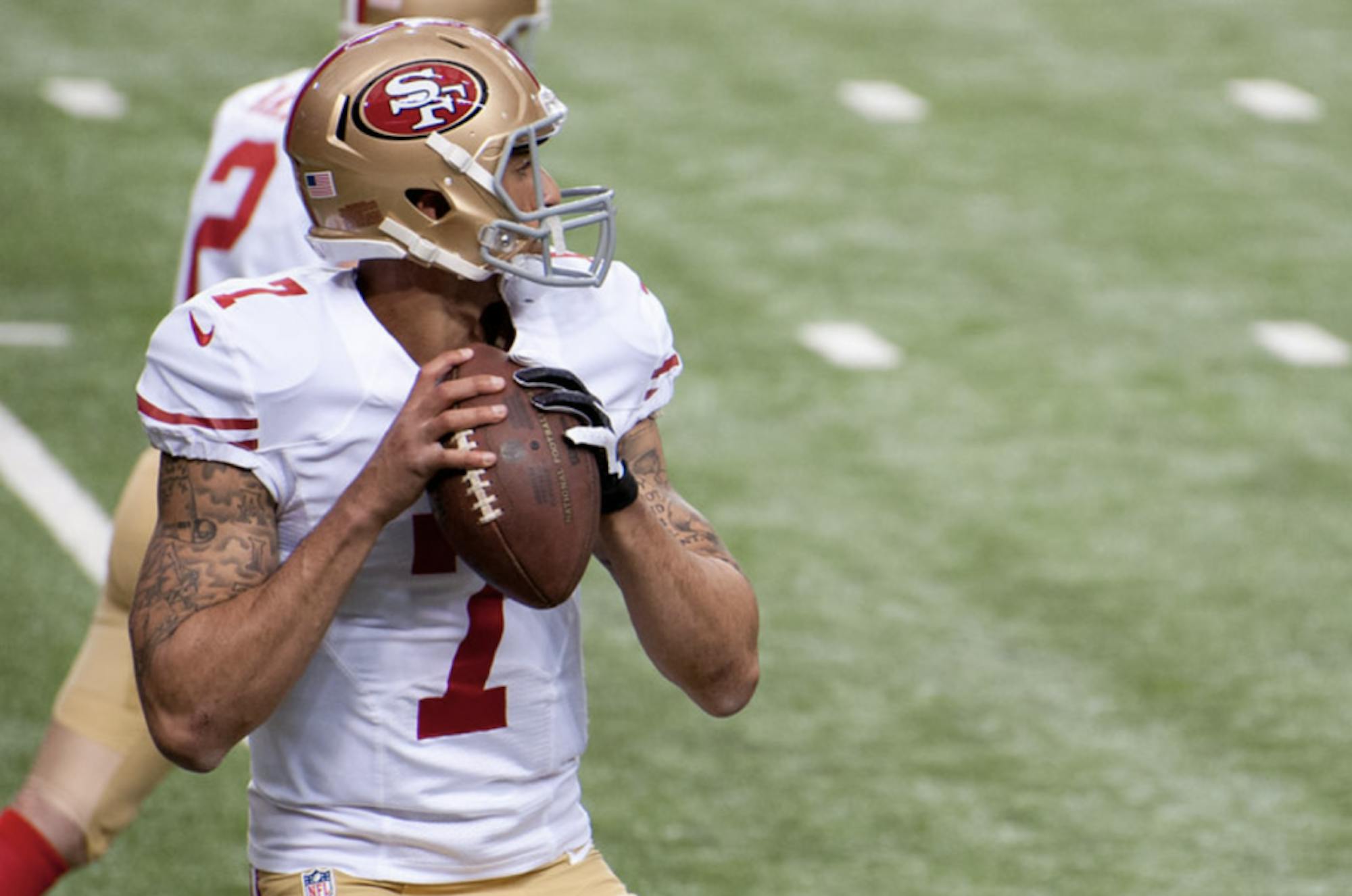1,520 days.
This is the amount of time that has passed since Colin Kaepernick last took a professional snap.Kaepernick is famous, or perhaps infamous, for kneeling during the national anthem, sparking a movement across the athletic industry.Despite the NFL’s attempts to prevent athlete participation through variousregulations, this silent protest spoke volumes during the 2016 season.The numerous cases of police brutality against Black Americans during the summer of 2016 prompted Kaepernick’s protest; hestated, “I am not going to stand up to show pride in a flag for a country that oppresses Black people and people of color.”
This movement was intensely controversial. At the start of that season, Kaepernick had the bestselling NFL jersey, yet the crowd often booed him as he protested, and many fans burned his jersey and jerseys of other players who began kneeling. Following the 2016 season, Kaepernick and the 49ers parted ways, and he has not played since.
In a league where more than 70% of the players are people of color, the NFL has long been scrutinized for its inconsistent responses to racist events. The Kaepernick saga is perhaps the peak of these contentions. Roger Goodell, commissioner of the NFL,stated at the time that he doesn’t "necessarily agree with what [Kaepernick] is doing.” The league's lack of action has become increasingly apparent, as it received backlash in recent months for failing to adequately address the tragic deaths of Breonna Taylor and George Floyd.It wasn’t until some of the league’s brightest stars released avideo pressuring the NFL into making a statement that Goodellsaid that “Black Lives Matter” and that the organization admits they were “wrong for not listening to NFL players earlier and encourage all to speak out and peacefully protest.”
The most recent controversy came in the form of a Super Bowl advertisement titled “Inspire Change," in which the NFL announced it was committing $250 million toward ending systemic racism. It is apparent that these statements in support of anti-racist movements are little more than carefully calculated, perfectly timed and performative efforts at atoning for the NFL's previous silence on the subject, because their prior stances now provoke an unprecedented volume of backlash. Although it is admirable that the NFL is attempting to make a difference, donations and vague statements are not sufficient. The underrepresentation of people of color in upper-level coaching and management is unacceptable and perpetuates these issues of racial injustice within the league. Rather than spearheading the necessary structural changes to make the NFL a more inclusive and progressive organization, the individual owners have only exacerbated the league’s vices.
There is a significant disconnect between the billionaire owners of the league, the players and the fans. Several owners have been subject to criticism for their racist beliefs and actions — late owner of the Houston Texans Bob McNairreferred to the league’s players as "inmates" and later stated that the sole thing he regretted about his words was apologizing for them. Similarly, New York Jets owner Woody Johnson made racist remarks that perpetuated harmful stereotypes about Black men’s fatherhood and questioned why Black History Month is celebrated. These are just a few of the various inexcusable statements NFL team owners have made. The organization’s lack of action stems from its structure; the commissioner has little incentive to inspire institutional change because hiscurrent contract, signed in 2017, stipulates that approximately 85% of his potential earnings are in the form of bonuses approved by team owners.Theoretically, Goodell’s role is to run the league and make fans happy. In reality, his job is to ensure that owners make a profit and augment his own paycheck, making him an unlikely candidate to enact change as he must appease those approving his bonuses.
The structure must change. We can no longer accept the NFL’s doing the bare minimum, and these changes must start at the top, through the owners. They decide who to hire, play a role in personnel decisions and ultimately set the tone for how their teams — and the NFL as a whole — deal with the issue of racism. One only needs to look to the NBA to see how a well-run organization can actively promote anti-racism. For example, the NBA banned Donald Sterling, former Los Angeles Clippers owner, for life and forced him to sell the team after his racist remarks were leaked. If the NFL’s mission were to take precedence over the individual ambitions of owners, activism could more easily prevail.
Put simply, the NFL must reorganize. If owners continue to hold all the power, the league will continue to partake in a cycle of performative activism.However, if millions of fans, who generate revenue for the league and its owners, come together and leverage their power, they can inspire necessary change within the league. Sports have long been a platform to speak about the issue of racial injustice in this country; as one of the most popular leagues in the United States, it’s troubling to see just how indifferent and insincere the NFL has been about racism. The “Inspire Change” movement and Kaepernick’s NFL-organized workout in 2019 are steps in the right direction, but they’re not enough. For true change, pressure must be placed on the league to prioritize players and fans over the self-interest of the owners.
When it comes to the anti-racist action of a league in which a majority of its players are people of color, the needs of the many must outweigh the comfort of the few.





